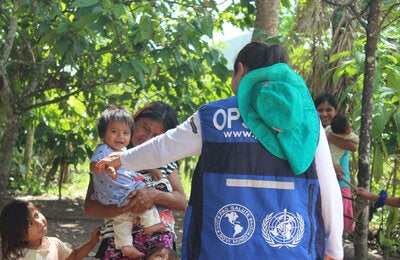
7 NOVEMBER 2017 | GENEVA - WHO is recommending that farmers and the food industry stop using antibiotics routinely to promote growth and prevent disease in healthy animals.
The new WHO recommendations aim to help preserve the effectiveness of antibiotics that are important for human medicine by reducing their unnecessary use in animals. In some countries, approximately 80% of total consumption of medically important antibiotics is in the animal sector, largely for growth promotion in healthy animals.
Over-use and misuse of antibiotics in animals and humans is contributing to the rising threat of antibiotic resistance. Some types of bacteria that cause serious infections in humans have already developed resistance to most or all of the available treatments, and there are very few promising options in the research pipeline.
"A lack of effective antibiotics is as serious a security threat as a sudden and deadly disease outbreak," says Dr Tedros Adhanom Ghebreyesus, Director-General of WHO. "Strong, sustained action across all sectors is vital if we are to turn back the tide of antimicrobial resistance and keep the world safe."
A systematic review published today in The Lancet Planetary Health found that interventions that restrict antibiotic use in food-producing animals reduced antibiotic-resistant bacteria in these animals by up to 39%. This research directly informed the development of WHO's new guidelines.
WHO strongly recommends an overall reduction in the use of all classes of medically important antibiotics in food-producing animals, including complete restriction of these antibiotics for growth promotion and disease prevention without diagnosis. Healthy animals should only receive antibiotics to prevent disease if it has been diagnosed in other animals in the same flock, herd, or fish population.
Where possible, sick animals should be tested to determine the most effective and prudent antibiotic to treat their specific infection. Antibiotics used in animals should be selected from those WHO has listed as being "least important" to human health, and not from those classified as "highest priority critically important". These antibiotics are often the last line, or one of limited treatments, available to treat serious bacterial infections in humans.
"Scientific evidence demonstrates that overuse of antibiotics in animals can contribute to the emergence of antibiotic resistance," says Dr Kazuaki Miyagishima, Director of the Department of Food Safety and Zoonoses at WHO. "The volume of antibiotics used in animals is continuing to increase worldwide, driven by a growing demand for foods of animal origin, often produced through intensive animal husbandry."
Many countries have already taken action to reduce the use of antibiotics in food-producing animals. For example, since 2006, the European Union has banned the use of antibiotics for growth promotion. Consumers are also driving the demand for meat raised without routine use of antibiotics, with some major food chains adopting "antibiotic-free" policies for their meat supplies.
Alternative options to using antibiotics for disease prevention in animals include improving hygiene, better use of vaccination, and changes in animal housing and husbandry practices.
WHO's Guidelines on use of medically important antimicrobials in food-producing animals build on decades of expert reports and evaluations of the role of agricultural antibiotic use in the increasing threat of antibiotic resistance. They contribute directly to the aims of the Global action plan on antimicrobial resistance adopted by the World Health Assembly in 2015 and the Declaration of the High-Level Meeting of the United Nations General Assembly on Antimicrobial Resistance, adopted in 2016.
The Pan American Health Organization (PAHO) works with the countries of the Americas to improve the health and quality of life of people throughout the Region. Founded in 1902, PAHO is the world's oldest international public health agency. It is the Regional Office of the WHO for the Americas and the specialized health agency of the Inter-American system.
World Antibiotic Awareness Week, 13-19 November 2017
This year's World Antibiotic Awareness Weektheme: "Seek advice from a qualified healthcare professional before taking antibiotics". Only take antibiotics after the prescription by a healthcare professional. Antibiotics are a precious resource, so it is important to get the right advice before taking them. This not only ensures people get the best treatment, responsible use of antibiotics will also help reduce the threat of antibiotic resistance.
Seven myths on the use of antibiotics
1. Antibiotics can cure any disease.
False: Antibiotics can only help combat some bacterial diseases. They are useless against back pain or the common cold, for instance.
2. Antibiotics have no side effects.
False: They can cause diarrhoea, nausea, and allergic reactions. In other cases, their side effects can go unrecognized.
3. The most expensive antibiotics are the best.
False: Traditional and inexpensive antibiotics such as penicillin, for example, are still very useful in combating bacterial infections.
4. The more bacteria an antibiotic kills, the better.
False: The human body has a variety of bacteria which are beneficial. If antibiotics kill those beneficial bacteria, it can have negative health impacts.
5. Antibiotics left over from previous prescriptions can still be used.
False: Previously prescribed antibiotics should not be used again, because every treatment is different for each person. Only a health care professional or doctor should decide on antibiotic treatments including dose and duration.
6. Antibiotic resistance happens when the body becomes resistant to antibiotics.
False: In fact bacteria-not humans or animals-become resistant to antibiotics and their spread causes hard-to-treat infections.
7. Antibiotic resistance is only a problem for people who take antibiotics.
False, In fact, anyone, of any age, in any country can get an antibiotic-resistant infection.
Note to editors:
Since 2005, WHO has published a list of critically important antimicrobials for human medicine, with regular revisions, to be used as a basis for promoting their prudent use. The list groups all antibiotics currently used in humans and animals into three categories - "important", "highly important" and "critically important" - based on their importance to human medicine.
The overall objective is to encourage prudent use to slow down antimicrobial resistance and preserve the effectiveness of the most critical antibiotics for medicine. The guidelines issued today incorporate this objective in its recommendations for antibiotic use in agriculture.
In the 5th revision of the list published in April 2017, the antibiotics considered highest priority amongst the critically important antimicrobials are quinolones, 3rd and higher generation cephalosporins, macrolides and ketolides, glycopeptides and polymyxins (also known as colistin). These antibiotics are essential as last-resort treatments for multidrug-resistant infections in humans.



